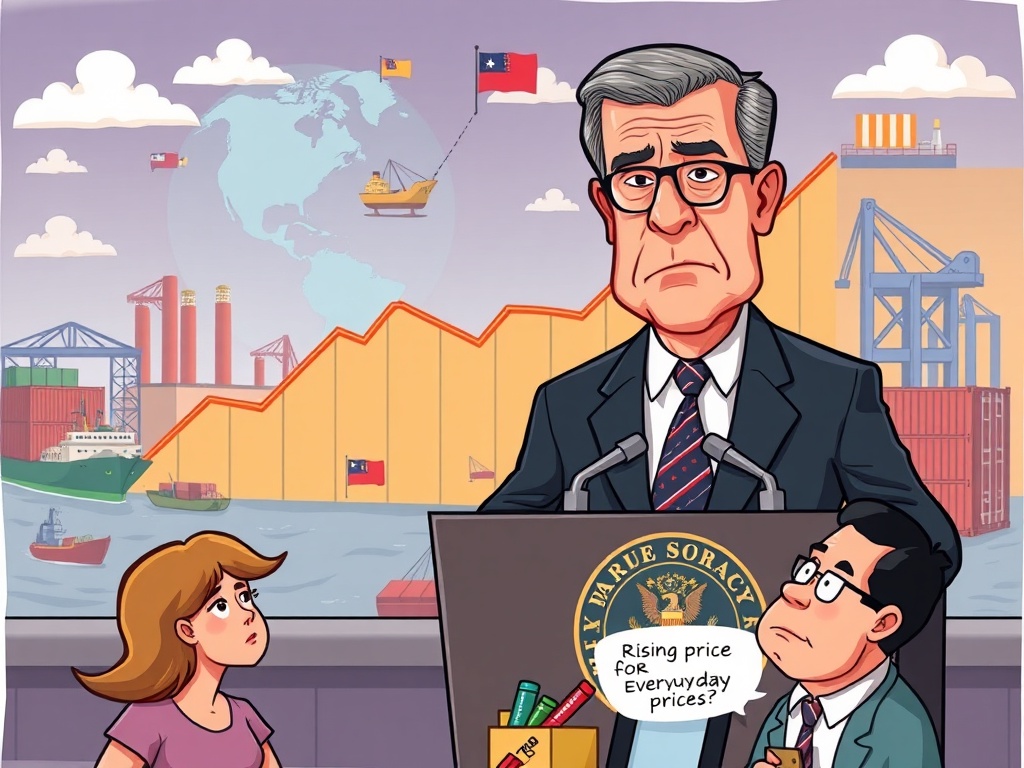BitcoinWorld

Tariff Impact on Economy: Powell Warns of Rising Prices and Inflationary Pressures
In the dynamic world of global finance and economics, statements from key figures like Jerome Powell, Chairman of the Federal Reserve, carry significant weight. For cryptocurrency enthusiasts and investors, understanding these macroeconomic signals is crucial, as they often ripple through traditional markets and influence digital asset valuations. Recently, Powell highlighted a critical issue: the direct connection between tariffs and rising commodity prices. This insight is not just a passing comment; it’s a window into the inflationary pressures that could shape monetary policy and, by extension, the economic landscape for months to come. Let’s dive deep into what Powell’s remarks mean for the broader Tariff Impact on Economy.
Understanding the Tariff Impact on Economy: What Did Powell Really Say?
Jerome Powell’s recent statements underscore a significant concern for the Federal Reserve. He explicitly noted that some commodity prices have indeed risen due to the imposition of tariffs. This isn’t just an observation; it’s a confirmation of an economic reality. Furthermore, the Fed anticipates that Personal Consumption Expenditure (PCE), a key inflation gauge, is projected to increase by 2.7% year-on-year through June. This figure is higher than the Fed’s typical 2% target, signaling potential inflationary pressures.
To grasp the full implications, let’s break down the core components of his statement:
- Tariffs and Commodity Prices: Tariffs are taxes imposed on imported goods. When these taxes are levied on raw materials or essential commodities, the cost of production for businesses increases. This elevated cost is often passed on to consumers in the form of higher prices for finished goods. Powell’s acknowledgement validates this direct link, highlighting how trade policy can fuel inflation.
- Personal Consumption Expenditure (PCE): The PCE index measures the prices of goods and services purchased by consumers. It’s the Federal Reserve’s preferred measure of inflation because it captures a broader range of spending and accounts for changes in consumer behavior. A projected 2.7% increase signifies that consumers are spending more, but a significant portion of that increase might be due to rising prices rather than increased consumption volume.
- Implications for Monetary Policy: The Fed’s dual mandate includes maintaining maximum employment and stable prices. When inflation, as indicated by PCE, starts to trend above their target, it typically signals a need for monetary policy adjustments, such as interest rate hikes, to cool down the economy and bring prices back under control.
How Does the Tariff Impact on Economy Ripple Through Consumer Spending?
The immediate consequence of rising commodity prices due to tariffs is felt directly by consumers. Imagine the domino effect:
Increased Production Costs:
- Businesses that rely on imported raw materials (e.g., steel, aluminum, agricultural products) face higher input costs due to tariffs.
- These costs eat into profit margins, forcing companies to make a choice: absorb the costs or pass them on.
Higher Consumer Prices:
- More often than not, businesses pass on these increased costs to the end-consumer. This means everything from your groceries to your new car might become more expensive.
- This phenomenon is known as cost-push inflation, where rising production costs lead to higher prices.
Erosion of Purchasing Power:
- When prices rise but wages don’t keep pace, consumers’ purchasing power diminishes. Their money buys less than it used to.
- This can lead to a decrease in overall consumer spending on non-essential items, potentially slowing economic growth.
Impact on Savings and Investments:
- Inflation erodes the real value of savings over time. If your savings account earns 1% interest but inflation is 2.7%, you’re effectively losing money.
- For investors, this means seeking assets that can act as a hedge against inflation, which often includes commodities or, for some, cryptocurrencies.
Beyond Commodity Prices: The Broader Tariff Impact on Economy
While the immediate focus is on commodity prices, the ramifications of tariffs extend far beyond. The interconnectedness of the global economy means that a tariff imposed by one nation can have a cascade of effects:
| Area of Impact | Description |
|---|---|
| Supply Chain Disruptions | Tariffs can force companies to re-evaluate their supply chains, seeking alternative, often more expensive, sources for materials. This can lead to delays and inefficiencies. |
| Reduced Trade Volumes | Higher costs associated with tariffs can reduce the overall volume of international trade, impacting global economic growth. |
| Retaliatory Measures | Often, tariffs lead to retaliatory tariffs from other countries, escalating trade disputes and harming export-oriented industries. |
| Investment Uncertainty | The unpredictable nature of trade wars and tariffs can deter foreign direct investment, as businesses become hesitant to commit capital in an unstable environment. |
These broader impacts can lead to slower economic growth, job losses in affected sectors, and increased market volatility, creating a challenging environment for businesses and investors alike.
Navigating the Tariff Impact on Economy: Strategies for Businesses and Investors
Given the potential for ongoing inflationary pressures due to tariffs, what steps can businesses and investors take?
For Businesses:
- Diversify Supply Chains: Reduce reliance on single-country suppliers, especially those from nations involved in trade disputes.
- Optimize Inventory Management: Hold sufficient inventory to mitigate short-term price spikes, but avoid overstocking which ties up capital.
- Explore Domestic Sourcing: If viable, shifting to domestic suppliers can reduce exposure to international tariffs.
- Improve Efficiency: Focus on internal cost reductions and operational efficiencies to offset rising input costs.
For Investors:
- Consider Inflation Hedges: Assets like real estate, certain commodities (e.g., gold, oil), and inflation-indexed bonds (TIPS) can perform well during inflationary periods.
- Evaluate Equity Exposure: Focus on companies with strong pricing power that can pass on higher costs to consumers without losing market share. Avoid companies with high import dependencies and low pricing power.
- Monitor Central Bank Actions: Keep a close eye on Federal Reserve announcements and other central bank policies, as interest rate decisions will significantly impact asset valuations.
- Cryptocurrency as an Alternative: While volatile, some investors view Bitcoin and other cryptocurrencies as a potential hedge against fiat currency debasement and inflation, particularly given their decentralized nature and finite supply (like Bitcoin’s 21 million coin cap).
Conclusion: The Enduring Challenge of Tariffs and Inflation
Jerome Powell’s recent remarks serve as a potent reminder that economic policies, even those seemingly distant from everyday life, have profound and direct consequences. The rising commodity prices attributed to tariffs are not merely abstract economic data points; they translate into higher costs for consumers and businesses, contributing to inflationary pressures that the Federal Reserve must address. As the PCE index continues to be closely watched, the Fed’s response will undoubtedly shape the future trajectory of interest rates, economic growth, and asset markets, including the volatile but increasingly relevant cryptocurrency space. Navigating this complex environment requires vigilance, strategic planning, and a keen understanding of the interplay between trade policy, inflation, and monetary action. The Tariff Impact on Economy is a challenge that demands our ongoing attention.
Frequently Asked Questions (FAQs)
Q1: What is Personal Consumption Expenditure (PCE) and why is it important?
A1: PCE measures the prices of goods and services purchased by consumers. It’s the Federal Reserve’s preferred inflation gauge because it covers a broad range of spending and accounts for consumer behavior shifts, providing a comprehensive view of inflationary pressures.
Q2: How do tariffs contribute to inflation?
A2: Tariffs are taxes on imported goods. When these taxes are applied to raw materials or components, they increase production costs for businesses. These higher costs are then typically passed on to consumers in the form of higher retail prices, leading to inflation.
Q3: What are the potential actions the Federal Reserve might take in response to rising inflation?
A3: If inflation rises above its target, the Federal Reserve might implement tighter monetary policies, such as increasing interest rates. This makes borrowing more expensive, which can cool down economic activity and help bring inflation back under control.
Q4: Can cryptocurrencies like Bitcoin act as a hedge against inflation caused by tariffs?
A4: Some investors view Bitcoin, with its finite supply, as a potential hedge against inflation and the devaluation of fiat currencies. However, cryptocurrencies are highly volatile, and their effectiveness as an inflation hedge is still a subject of ongoing debate and depends on various market factors.
Q5: How can businesses mitigate the negative effects of tariffs?
A5: Businesses can mitigate tariff impacts by diversifying their supply chains, optimizing inventory management, exploring domestic sourcing options, and focusing on internal operational efficiencies to reduce overall costs.
Enjoyed this insightful analysis? Share it with your friends and colleagues on social media to help them understand the crucial connections between global trade policies, inflation, and their everyday finances!
To learn more about the latest explore our article on key developments shaping the crypto market and its future oriented activity.
This post Tariff Impact on Economy: Powell Warns of Rising Prices and Inflationary Pressures first appeared on BitcoinWorld and is written by Editorial Team





